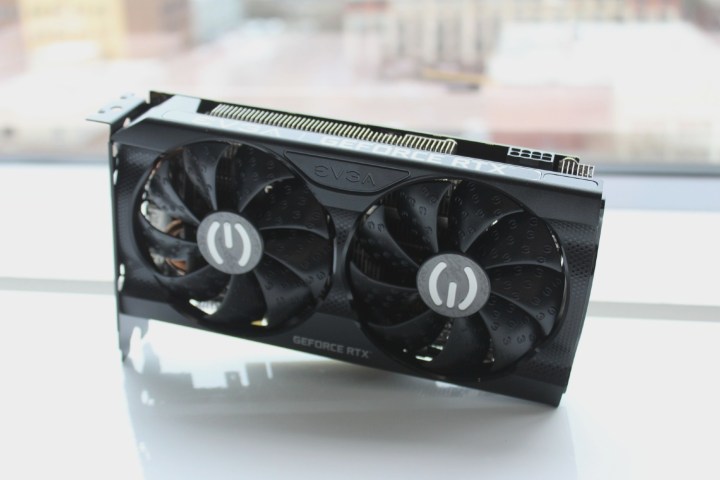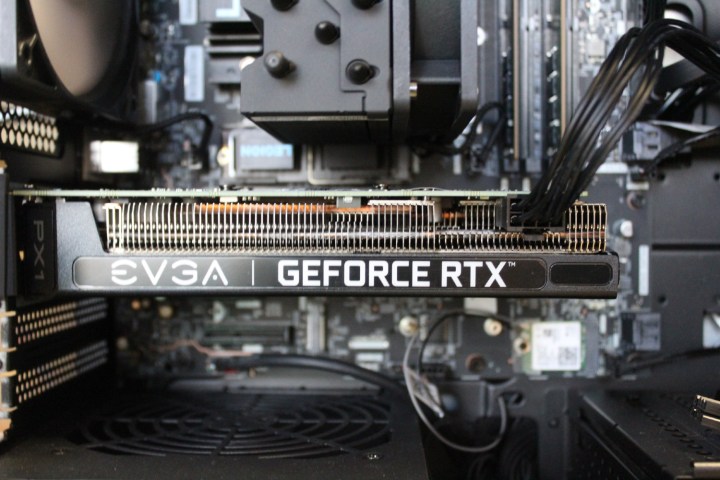In terms of performance, Nvidia’s RTX 3000 series graphics cards have been a rousing success. But in every other way, it’s been a bit of disaster.
The confluence of supply limitations, another explosion in crypto mining, and unexpectedly huge demand have made it nearly impossible to buy one of these new graphics cards. I hope the new GeForce RTX 3060 gets into more gamers’ hands, but there’s no guarantee.
The good news? If you are able to snag one, you’ll be very pleased by the massive upgrade it will offer to your rig.
Design

Nvidia isn’t releasing a first-party version of the RTX 3060. That’s a shame. Not only do these “Founders Edition” models set a good standard for pricing, they also are the prettiest graphics card you can buy. With the gorgeous redesign of the 30-series cards, that’s a shame. Unfortunately, the EVGA RTX 3060 XC Black graphics card I received as a review unit isn’t as much of a looker.
It’s not ugly, but it lacks a backplate, the shroud is entirely plastic, and you won’t find much in the way of lighting. You’ll have to pay $60 more if you want a model with a backplate. The good news? It uses a standard 8-pin power connector, unlike the odd 12-pin connectors found in the Founders Edition that require an adapter.
Of course, what you give up in beauty with partner models, you gain in cooling performance.
It’s a 2-slot thermal solution that’s identical in size to the RTX 3060 Ti and RTX 3070, though it’s only one of many third-party cards that will be available. It would be a good choice for smaller micro ITX builds where space is limited.

On back, you’ll find three DisplayPort 1.4b interfaces and an HDMI 2.1 port, giving you plenty of options for powering up to four displays at up to 4K resolution at 120Hz.
Specs

Both AMD and Nvidia often like to talk about recapturing the popularity of the GTX 1060. It’s from 2016, and it’s still the most common graphics card you’ll find used in Steam hardware surveys. At $200 (or $299 for the Founders Edition of the 6GB model), the GTX 1060 became the standard for midrange PC gaming, and no card since has managed to capture its lightning-in-a-bottle success.
Judging by the name, you might think the RTX 3060 is a 2021 successor to the 1060. Nvidia calls it the “ultimate upgrade for GTX 1060 gamers. Just as the GTX 1060 had powered all the new games at 1080p/60 [frames per second], the RTX 3060 brings modern 1080p gaming to users.”
If we’re talking about the 6GB version of the GTX 1060, Nvidia might be right. The RTX 3060 starts at $329 — which is only $30 more expensive than the GTX 1060. Importantly, it’s also $20 cheaper than its predecessor, the RTX 2060 Super. It’s also $70 cheaper than the RTX 3060 Ti, which puts it squarely in midrange territory.
When you consider the performance potential of the RTX 3060, that’s impressive. Based on Nvidia Ampere architecture and Samsung’s 8nm node, the RTX 3060 has all the improvements to efficiency under the hood, as well as support for ray tracing and DLSS, of course.
But how does it compare to the RTX 3060 Ti, RTX 2060 Super, and other cards? Here are the specs:
| RTX 3060 | RTX 3070 | RTX 3060 Ti | RTX 2060 Super | RTX 1060 | |
| CUDA cores | 3584 | 5888 | 4864 | 2176 | 1280 |
| RT Cores | 28 | 46 | 38 | 34 | n/a |
| Base clock | 1.32GHz | 1.50GHz | 1.41GHz | 1.47GHz | 1.51GHz |
| Boost clock | 1.78GHz | 1.73GHz | 1.67GHz | 1.65GHz | 17.1GHz |
| Memory | 12GB GDDR6 | 8GB GDDR6 | 8GB GDDR6 | 8GB GDDR6 | 6GB GDDR5 |
| Memory interface | 192-bit | 256-bit | 256-bit | 256-bit | 192-bit |
| TDP | 170w | 220w | 200w | 175w | 120w |
The impressive RTX 3060 Ti has 26% more CUDA cores than the RTX 3060. Meanwhile, the RTX 3060 has 39% more CUDA cores than the RTX 2060 Super. The TDP and memory are also key specifications for the RTX 3060 that should play into performance. It has a whopping 12GB of GDDR6 video memory, which is even more than the RTX 3080. That’s a strange feature for a midrange gaming GPU. It’s also rated at a 170-watt power envelope, which is five watts less than the RTX 2060 Super.
Now, the RTX 3060 Ti and 3070 are based on the same GA104 graphics processor, which explains why their performance was fairly close. The RTX 3060 is based on the GA106, meanwhile.
Lastly, the RTX 3060 is rated at 170 watts of power consumption, five watts less than the RTX 2060 Super and 30 watts less than the RTX 3060 Ti. That also means you can save a bit of cash on your power supply, as Nvidia recommends you can get away with just a 550-watt power supply instead of a 600-watt one.
If the RTX 3060 can deliver on the potential of its CUDA core count and 12GB of RAM in a $329 package, Nvidia might have another serious winner on its hands.
Game performance

I tested the EVGA RTX 3060 XC in a test system with the Intel Core i7-10700, 16GB of RAM, a 650-watt power supply, and a 512GB M.2 SSD. I ran the GPU through 3DMark Time Spy, Civilization VI, Assassin’s Creed Valhalla, Battlefield V, and Fortnite.
Let’s start with Time Spy. The EVGA RTX 3060 benchmarked quite nicely, slotting in around 14% behind the RTX 3060 Ti. That’s also just 12% behind the RTX 2070 Super, which was a $500 at launch. Choosing between the RTX 3060 and RTX 3060 Ti is tough, though.
When it comes to gaming, the RTX 3060 shines in 1440p, while 4K is more hit-or-miss, and you’ll likely feel a bit more comfortable choosing one of the more expensive RTX 30-series cards that are designed for that resolution. Both Battlefield V and Fortnite couldn’t quite hit that 60 frames per second (fps) standard. Let’s be honest —
Even so, less demanding strategy games like Civilization VI averaged 77 fps in 4K and looked gorgeous in the native
All three of these games played beautifully in 1440p with max settings. Battlefield V hit 85 fps, Civilization VI hit 114 fps, and Fortnite hit 94 fps. In Fortnite and Battlefield V, the RTX 3060 even beat the RTX 2070 Super by a few frames per second.
Also impressive, the RTX 3060 handled the heavy load of Assassin’s Creed Valhalla with surprising grace. It averaged 64 fps in the game’s built-in benchmark.
Of course, there will be the occasional game that can’t quite hit 60 fps at max settings in 1440p, such as Cyberpunk 2077 or Control. That’s especially true if you’re cranking up the ray tracing effects. But that was also true of the RTX 3060 Ti, and there are always ways to mitigate that, whether by dropping settings or using DLSS.
You can also always drop to 1080p, of course, and enjoy up to a 32% increase in frame rates. That’s helpful if you want to play those demanding games or if you want to get closer to 144 fps in more competitive, twitchy shooters. In 1080p at max settings, Fortnite averaged 138 fps in 1080p and Battlefield V averaged 105 fps.
Throughout all these games, the Radeon RX 5700 XT stays 4 to 5 fps ahead of the RTX 3060. For a much larger and more expensive card, that should be assumed.
In content creation, though, those tables are turned, which is good news for the RTX 3060.
Content creation performance
The RTX 3060 is undoubtedly meant for gamers first, but with 12GB of video memory onboard, I was curious how this GPU could speed up heavy workloads in creative applications.
I tested both video editing and 3D modeling, and the results were spectacular. For video editing, I ran PugetBench, a benchmark in Adobe Premiere Pro that tests tasks like 4K playback, encoding, and more.

It thoroughly destroys the $349 Radeon RX 5700, though you’ll be hard-pressed to find one at that price these days. The RTX 3060 is 21% faster overall, with a noteworthy lead in 4K playback. It’s even 17% faster than the Radeon RX 5700 XT in Premiere Pro performance. That’s not an insignificant lead with cards this close in price, especially since the RX 5700 XT consumes more power and has a higher systemwide wattage requirement.
The RTX 3060 gets an easy recommendation for video editors working in 4K at a reasonable price. That’s the power of Nvidia’s CUDA API.
The RTX 3060 also impressed in PCMark 10’s Creative benchmark, which extends to tasks like photo editing. Here, the RX 5700 XT does beat the RTX 3060 by 14%.
For 3D modeling, I ran the first three tests in the Blender benchmark. Here, the RTX 3060 beats the RTX 2070 Super without breaking a sweat. It even trades blows with the RTX 2080 Ti, beating it in the “classroom” render by two seconds. Of course, GPUs like the RTX 3080 blow it out of the water. But it just goes to show how powerful the Ampere architecture really is.
Best of all, throughout all my testing, the EVGA RTX 3060 remained fairly cool and quiet. The average temperature during 3DMark Time Spy was 43 degrees Celsius, peaking at 75 degrees.
You should buy it?
Yes, if you can get your hands on it. The EVGA RTX 3060 XC Black represents the lower end of the price spectrum for the 3060, meaning you’re getting the best performance-per-dollar. It’s missing some features like a backplate and RGB lighting — and a spruced-up model with better cooling should eke out some extra performance, too. But you don’t want to end up paying RTX 3060 Ti prices, which is where the lines can get blurry.
Of course, in the current market, these prices are all hypothetical. The RTX 3060 will inevitably get hit by price inflation, low stock, and scalping. But for a GPU at this price, it’s a lot of performance, both in gaming and creative applications.
If you’re lucky enough to get one at this price, don’t hesitate.



